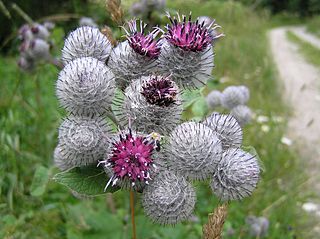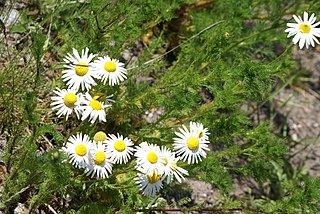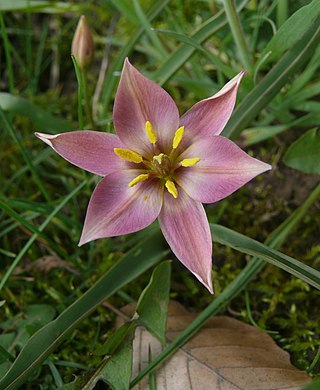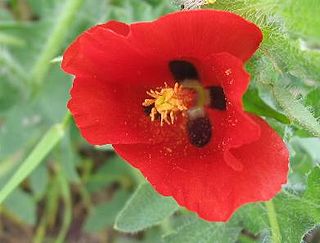
Arctium is a genus of biennial plants commonly known as burdock, family Asteraceae. Native to Europe and Asia, several species have been widely introduced worldwide. Burdock's clinging properties, in addition to providing an excellent mechanism for seed dispersal, led to the invention of the hook and loop fastener.

Matthiola is a genus of flowering plant in the mustard family Brassicaceae. It is named after Italian naturalist Pietro Andrea Mattioli (1501–1577). The genus contains about 50 species of annual, biennial and perennial herbaceous plants and subshrubs. Many are cultivated for their heavily scented, colorful flowers.

Alcea is a genus of over 80 species of flowering plants in the mallow family Malvaceae, commonly known as the hollyhocks. They are native to Asia and Europe. The single species of hollyhock from the Americas, the streambank wild hollyhock, belongs to a different genus.

Glaucium is a genus of about 25 species of annual, biennial or perennial herbaceous flowering plants in the family Papaveraceae, native to Europe, north Africa, and southwest and central Asia. The species commonly occur in saline habitats, including coasts and salt pans.

Tripleurospermum is a genus in the chamomile tribe within the sunflower family. Mayweed is a common name for plants in this genus.

Glaucium flavum, the yellow horned poppy, yellow hornpoppy or sea poppy, is a summer flowering plant in the family Papaveraceae. It is native to Europe, Northern Africa, Macaronesia and temperate zones in Western Asia. The plant grows on the seashore and is never found inland. All parts of the plant, including the seeds, are toxic. It is classed as a noxious weed in some areas of North America, where it is an introduced species. It is grown in gardens as a short-lived perennial but usually grown as a biennial.

Colpodium is a genus of plants in the grass family, native primarily to Asia but with a few species on certain mountains in Africa.

Glaucine(1,2,9,10-TetraMethoxyAporphine, Bromcholitin, Glauvent, Tusidil, Tussiglaucin) is an aporphine alkaloid found in several different plant species in the family Papaveraceae such as Glaucium flavum, Glaucium oxylobum and Corydalis yanhusuo, and in other plants like Croton lechleri in the family Euphorbiaceae.
Pyrus boissieriana, the Boissier pear and telka, is a species of Pyrus (pear) native to southwestern Turkey as well as the Kopet Dag region on the Turkmenistan and Iranian border. In its native locales it is cultivated as a rootstock for domestic pears.

Schistostephium is a genus of African plants in the chamomile tribe within the daisy family.
Pseudosedum is a genus of flowering plants in the family Crassulaceae.

Tulipa humilis is a species of flowering plant in the lily family, found in Syria, Lebanon, Palestine, Turkey, Iran, and the North Caucasus region of Russia. The flowers are pink with yellow centers. Its preferred habitat are rocky mountain slopes. It is known by several other names in horticulture.
Alcea tabrisiana is a species of flowering plant in the hollyhock genus Alcea, family Malvaceae. It is native to Turkey, the Transcaucasus, and Iran. It occurs on dry stony slopes, in mountain steppe and in forests, between 750 and 1,750 m elevation.

Glaucium corniculatum, the blackspot hornpoppy or red horned-poppy, is a species of the genus Glaucium in the poppy family (Papaveraceae). It is an annual flowering plant, occurring in southern Europe, and grows up to 1 foot (30 cm) high. The stem and leaves are hairy, the capsule fruit is covered with stiff hair, the flower is red, with a black spot on the base of the tepal bract, which has a yellow margin around it. The flower appears from June until August.

Garhadiolus is a genus of Asian plants in the tribe Cichorieae within the family Asteraceae.
Friedrich Alexander Buhse was a Baltic-German botanist.

Glaucium secmenii is a species of flowering plant in the horned poppy genus which is endemic to Turkey.

Glaucium grandiflorum, the great-flowered horned poppy, is a species of flowering plant in the horned poppy genus which is native to the Middle East.
Glaucium calycinum is a species of flowering plant in the horned poppy genus which is endemic to Iran.
Glaucium cuneatum is a species of flowering plant in horned poppy genus which is native to Iraq.














